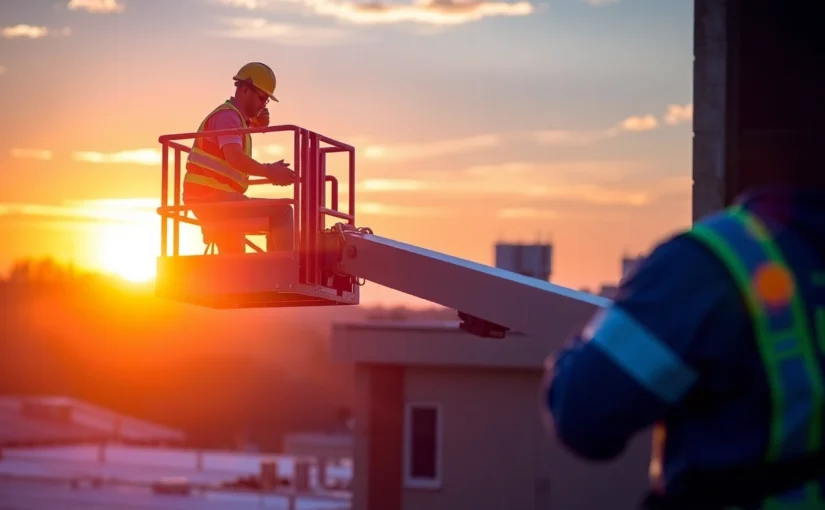Understanding Aerial Work Platforms and Their Rental Options
In the dynamic world of construction, maintenance, and industrial operations, reaching heights safely and efficiently is paramount. Aerial work platforms (AWPs), also known as mobile elevating work platforms (MEWPs), offer versatile solutions for elevating workers and equipment to otherwise inaccessible heights. Whether undertaking building renovations, electrical installations, or safety inspections, the right aerial work platform can significantly enhance productivity and safety.
For businesses and contractors operating within the UK, renting rather than purchasing AWPs is often the most practical and cost-effective strategy. Aerial work platforms rental provides access to a broad range of equipment tailored to specific project needs, without the burdens of ownership, maintenance, and storage. This comprehensive guide delves into the types of AWPs available for rent, key features to consider, the benefits of renting, factors influencing rental costs, best practices for usage, and how to select a reliable rental provider.
Types of Aerial Work Platforms Available for Rent
Aerial work platforms encompass a variety of equipment designed to suit different operational requirements and site conditions. Understanding the distinctions among these types is essential for selecting the optimal solution for your project.
Scissor Lifts
Scissor lifts are characterized by their robust, vertically extendable platforms supported by a crisscrossing arm structure. They are ideal for projects requiring stable platforms at moderate heights, typically between 2 and 14 meters. Scissor lifts provide large work areas, making them suitable for tasks like painting, electrical work, and stockroom maintenance. Their straightforward operation and safety features make them popular in indoor and outdoor applications.
Boom Lifts
Boom lifts, also known as cherry pickers or aerial platforms, feature an extendable arm (articulated or telescopic) that allows access to hard-to-reach areas at varying angles. These lifts can reach heights from 10 to over 40 meters, providing exceptional flexibility for complex projects such as building facades, tree trimming, and installation work. They come in various configurations:
- Articulating boom lifts: Equipped with multiple joints, enabling precise positioning around obstacles.
- Telescopic boom lifts: Featuring straight, extendable arms for reaching over distances.
Vertical Mast and Personnel Lifts
These lifts are specialized for vertical elevation, often used for maintenance, electrical work, and repairs at heights up to 20 meters. They are portable, easy to operate, and often electric-powered, making them suitable for indoor use.
Specialized Lifts
Additional types include spider lifts, truck-mounted lifts, and crawler lifts, each tailored for niche applications such as navigating rough terrain or providing access in confined spaces.
Key Features and Specifications to Consider
Selecting the right aerial work platform involves assessing various features and specifications to match the operational demands of your project.
Working Height and Load Capacity
The primary consideration is the maximum working height the platform can reach. Ensure the platform’s height exceeds your target working level to account for safety and operational overhead. Load capacity is equally critical, as it determines the weight limit for operators, tools, and materials. Overloading can compromise safety and equipment integrity.
Platform Dimensions and Accessibility
Platform size influences the type of tasks that can be performed and the number of personnel or equipment it can accommodate. Additionally, the platform’s maneuverability, including turning radius and ease of deployment, affects operational efficiency, especially in confined spaces.
Power Source
AWPs are powered by electric, diesel, or hybrid engines. Electric platforms are preferable indoors due to zero emissions and quieter operation, while diesel-powered lifts are suitable for outdoor, rough-terrain environments. Hybrid models offer versatility across diverse work sites.
Mobility and Stability Features
Evaluate the platform’s mobility features—such as self-propulsion, track-based movement, or compatibility with lifting accessories. Stability features like outriggers and stabilizers are essential on uneven terrain to prevent tipping.
Safety Features
Ensuring the platform includes safety mechanisms such as emergency lower controls, guardrails, harness attachment points, and load sensors is vital. Compliance with UK safety standards (e.g., LOLER) is mandatory.
Selecting the Right Platform for Your Project Needs
To maximize efficiency and safety, matching the platform type and specifications to your specific project parameters is crucial.
Assessing Project Scope and Conditions
Begin by defining the scope: What tasks need to be performed, at what heights, and in what environment? For indoor projects with low ceilings, electric scissors lifts may suffice. For outdoor facade work, an articulated boom lift with high outreach capabilities might be necessary.
Evaluate Accessibility and Space Constraints
Consider site conditions—narrow doorways, tight corners, and uneven terrain influence platform choice. Compact models or tracked lifts may be optimal where space is limited.
Consider Duration and Frequency of Use
Short-term projects benefit from flexible rental options, while ongoing maintenance tasks may justify longer-term leases or frequent rentals. Planning ahead allows for better budgeting and equipment availability.
Consultation and Expert Guidance
Engaging with rental specialists or site safety consultants can help identify the most suitable equipment, ensuring compliance and operational efficiency.
Benefits of Renting Aerial Work Platforms for Your Business
Cost Efficiency Compared to Buying
Investing in aerial work platforms involves significant capital expenditure, maintenance costs, and storage considerations. Renting offers a cost-effective alternative, allowing businesses to access the latest models without upfront investment. Rental costs are typically predictable, with flexible terms tailored to project durations. Additionally, maintenance, repairs, and upgrades are responsibilities of the rental provider, reducing operational costs and downtime for your team.
Enhanced Safety and Compliance Standards
Rental providers maintain their equipment to meet strict safety standards and UK regulations such as LOLER (Lifting Operations and Lifting Equipment Regulations). Regular inspections, servicing, and certification ensure the equipment’s reliability. Using properly maintained and certified platforms minimizes the risk of accidents and legal liabilities, fostering a safer work environment.
Flexibility and Access to Latest Models
Rental agreements provide access to a diverse fleet of high-specification equipment, including the newest models with advanced safety features and technological enhancements. This flexibility allows project managers to select the most appropriate platform for each task, switching equipment as project scopes evolve.
Factors Influencing Aerial Work Platforms Rental Costs
Duration-Based Pricing and Rental Terms
Rental costs are primarily influenced by the length of the hire period. Short-term rentals (daily or weekly) tend to cost more on a per-day basis, whereas long-term or monthly rentals often benefit from discounted rates. Clear rental terms—such as inclusion of delivery, setup, and maintenance—impact overall pricing.
Type, Height Capacity, and Workload
More complex and capable platforms, such as high-reaching articulated boom lifts or heavy-duty scissor lifts, generally command higher rental rates. The height capacity, outreach distance, and load limits directly affect cost. Specialized features like four-wheel drive or tracking capability for rough terrain also add to expenses.
Additional Services: Delivery, Setup, Maintenance
Services such as equipment delivery to site, onsite setup, operator training, and ongoing maintenance can influence rental prices. Many providers offer all-inclusive packages, providing peace of mind and simplifying logistics.
Best Practices for Safe and Effective Usage
Operator Training and Certification Requirements
Proper operator training is essential to ensure safe handling and compliance with UK regulations. Certified operators are knowledgeable in operating procedures, hazard recognition, and emergency protocols. Many rental providers offer training courses or require proof of certification before rental.
Pre-Rental Inspections and Safety Checks
Before use, conduct thorough inspections for structural integrity, hydraulic and electrical systems, safety devices, and signs of wear or damage. Document inspections and adhere to maintenance schedules to prevent malfunctions during operation.
Proper Handling and Storage During Use
Operators should follow manufacturer guidelines for handling, including stability checks and safe positioning. During breaks, equipment should be stored in designated areas to prevent theft, vandalism, or damage. Always engage safety features when the platform is stationary.
How to Choose a Reliable Aerial Platforms Rental Provider
Assessing Supplier Reputation and Experience
Select providers with proven track records, positive customer reviews, and extensive experience in the industry. Verify compliance with UK safety standards and inquire about their equipment maintenance protocols.
Comparing Rental Terms and Customer Support
Analyze rental agreements for flexibility, clarity, and included services. Superior customer support, responsive communication, and comprehensive training are indicators of a trustworthy partner.
Leveraging Local Rental Options for Convenience
Local providers can offer faster delivery, in-person support, and customized solutions tailored to regional project demands. Utilizing regional rental companies also promotes community engagement and supports local economy.

